Buildings.Electrical.AC.ThreePhasesBalanced.Lines.Examples
Package with example models
Information
This package contains examples for the use of models that can be found in Buildings.Electrical.AC.ThreePhasesBalanced.Lines.
Extends from Modelica.Icons.ExamplesPackage (Icon for packages containing runnable examples).
Package Content
| Name | Description |
|---|---|
| Test model for single phase lines that use commercial cables | |
| Test model for a single phase line that uses medium voltage commercial cable information | |
| Test model for single phase inductive lines | |
| Test model for single phase resistive lines | |
| Test model for single phase inductive-resistive lines | |
| Test model for a network model | |
| Test model for a network model with medium voltage |
 Buildings.Electrical.AC.ThreePhasesBalanced.Lines.Examples.ACLine
Buildings.Electrical.AC.ThreePhasesBalanced.Lines.Examples.ACLine
Test model for single phase lines that use commercial cables
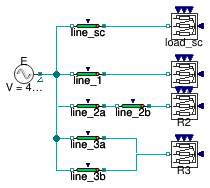
Information
This example demonstrates how to use a line model to connect a source to a load that uses commercial cables.
The model has four different loads. The load sc_load represents
a short circuit R=0. The current that flows through the load depends
on the impedance of the line.
The remaining three loads R1, R2, and R3
are resistive loads. Each load is connected to the source with different configurations.
However, the equivalent impedance between each load and the source is the same.
Since the equivalent impedances are the same, each load draws the same current.
Extends from Modelica.Icons.Example (Icon for runnable examples).
Modelica definition
 Buildings.Electrical.AC.ThreePhasesBalanced.Lines.Examples.ACLineMedium
Buildings.Electrical.AC.ThreePhasesBalanced.Lines.Examples.ACLineMedium
Test model for a single phase line that uses medium voltage commercial cable information
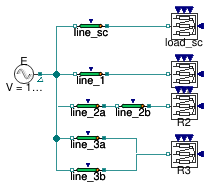
Information
This example demonstrates how to use a line model to connect a source to a load that uses medium voltage commercial cable information.
The model has four different loads. The load sc_load represents
a short circuit R=0. The current that flows through the load depends
on the impedance of the line.
The remaining three loads R1, R2, and R3
are resistive loads. Each load is connected to the source with different configurations,
however the equivalent impedance between each load and the source is the same.
Since the equivalent impedances are the same, each load draws the same current.
Note:
ThreePhasesBalanced.Lines.Line line_1(
V_nominal=220,
P_nominal=5000,
l=2000,
redeclare Buildings.Electrical.Transmission.MediumVoltageCables.Generic
commercialCable = Buildings.Electrical.Transmission.MediumVoltageCables.Annealed_Al_10 ())
"Resistive line that connects to load 1"
The code snippet shows how a line model line_1 redeclared its
record type in order to be Buildings.Electrical.Transmission.MediumVoltageCables.Generic.
Extends from Modelica.Icons.Example (Icon for runnable examples).
Modelica definition
 Buildings.Electrical.AC.ThreePhasesBalanced.Lines.Examples.ACLine_L
Buildings.Electrical.AC.ThreePhasesBalanced.Lines.Examples.ACLine_L
Test model for single phase inductive lines
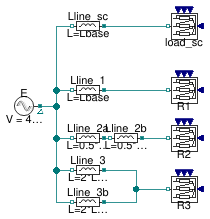
Information
This example demonstrates how to use a purely inductive line model to connect a source to a load.
The model has four different loads. The load sc_load represents
a short circuit R=0. The current that flows through the load depends
on the inductance of the line.
The remaining three loads R1, R2, and R3
are resistive loads. Each load is connected to the source with different configurations.
However, the equivalent impedance between each load and the source is the same.
Since the equivalent impedances are the same, each load draws the same current.
Extends from Modelica.Icons.Example (Icon for runnable examples).
Parameters
| Type | Name | Default | Description |
|---|---|---|---|
| Inductance | Lbase | 10/2/Modelica.Constants.pi/60 | Base value for the line inductances [H] |
Modelica definition
 Buildings.Electrical.AC.ThreePhasesBalanced.Lines.Examples.ACLine_R
Buildings.Electrical.AC.ThreePhasesBalanced.Lines.Examples.ACLine_R
Test model for single phase resistive lines
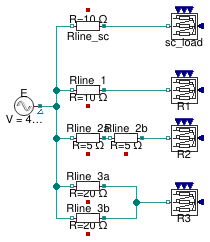
Information
This example demonstrates how to use a resistive line model to connect a source to a load.
The model has four different loads. The load sc_load represents
a short circuit R=0. The current that flows through the load depends
on the resistance of the line.
The remaining three loads R1, R2, and R3
are resistive loads. Each load is connected to the source with different configurations.
However, the equivalent resistance between each load and the source is the same.
Since the equivalent resistances are the same, each load draws the same current.
Extends from Modelica.Icons.Example (Icon for runnable examples).
Modelica definition
 Buildings.Electrical.AC.ThreePhasesBalanced.Lines.Examples.ACLine_RL
Buildings.Electrical.AC.ThreePhasesBalanced.Lines.Examples.ACLine_RL
Test model for single phase inductive-resistive lines
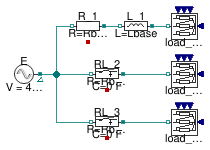
Information
This example demonstrates how to use a resistive-inductive line model to connect a source to a load.
The model has three loads load_sc_1, load_sc_2,
and load_sc_3 representing short circuits R=0.
The current that flows through the load depends on the impedance of the line.
Each load is connected to the source with different configurations. However, the equivalent impedance between each load and the source is the same. Since the equivalent impedances are the same, each load draws the same current.
Note:
The line model RL_3 is the same as RL_2 but it uses
dynamic phasors.
Extends from Modelica.Icons.Example (Icon for runnable examples).
Parameters
| Type | Name | Default | Description |
|---|---|---|---|
| Resistance | Rbase | 10 | Base value for the line resistance [Ohm] |
| Inductance | Lbase | Rbase/2/Modelica.Constants.p... | Base value for the line inductance [H] |
Modelica definition
 Buildings.Electrical.AC.ThreePhasesBalanced.Lines.Examples.ACSimpleGrid
Buildings.Electrical.AC.ThreePhasesBalanced.Lines.Examples.ACSimpleGrid
Test model for a network model
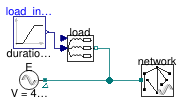
Information
This example demonstrates how to use a network model to connect a source to a load. In this simple case the network has two nodes that are connected by a commercial line cable.
At the beginning of the simulation the load consumes power while at the and it produces power. The voltage at the load at the beginning is lower than the nominal RMS voltage (480 V) while at the end of the simulation it is higher. The voltage drop and increase are due to the presence of the cable between the source and the load.
The network uses cables of the type LowVoltageCable.Cu35 with
a length of 200 m.
The picture below describes the grid topology.

Extends from Modelica.Icons.Example (Icon for runnable examples).
Modelica definition
 Buildings.Electrical.AC.ThreePhasesBalanced.Lines.Examples.ACSimpleGridMedium
Buildings.Electrical.AC.ThreePhasesBalanced.Lines.Examples.ACSimpleGridMedium
Test model for a network model with medium voltage
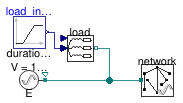
Information
This example demonstrates how to use a network model to connect a source to a load (using a medium voltage cable). In this simple case the network has two nodes that are connected by a commercial line cable.
At the beginning of the simulation the load consumes power while at the end it produces power. The voltage at the load at the beginning is lower than the nominal RMS voltage (15 kV) while at the end of the simulation it is higher. The voltage drop and increase are due to the presence of the cable between the source and the load.
The network uses cables of the type MediumVoltageCables.Annealed_Al_30 with
a length of 200 m.
The picture below describes the grid topology.

Note:
The cables are usually defined using the LowVoltageCable.Generic type. In order to use a
medium voltage cable it is necessary to redeclare the type of the record commercialCable.
ThreePhasesBalanced.Lines.Network network(
redeclare Buildings.Electrical.Transmission.Grids.TestGrid2NodesMedium grid,
lines( redeclare Buildings.Electrical.Transmission.MediumVoltageCables.Generic
commercialCable = network.grid.cables,
each V_nominal = network.V_nominal),
V_nominal=15000)
The code snippet shows how each line that is part of the vector lines is
redeclared in order to have as type the record
Buildings.Electrical.Transmission.MediumVoltageCables.Generic. The lines are initialized
using the cables of the grid network.grid.cables. All the lines have the same
nominal voltage each V_nominal = network.V_nominal.
Extends from Modelica.Icons.Example (Icon for runnable examples).
